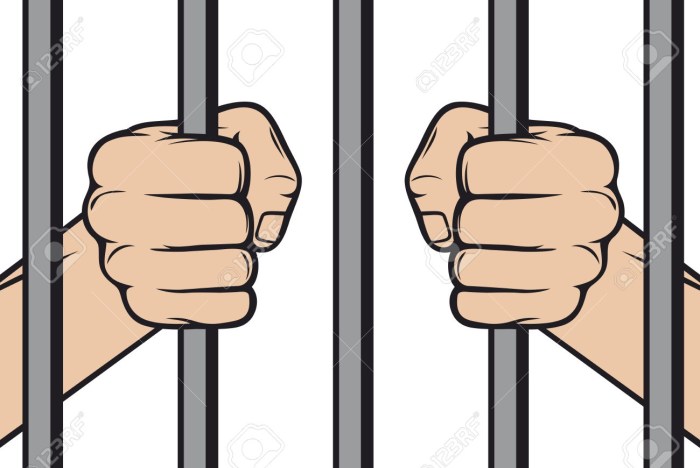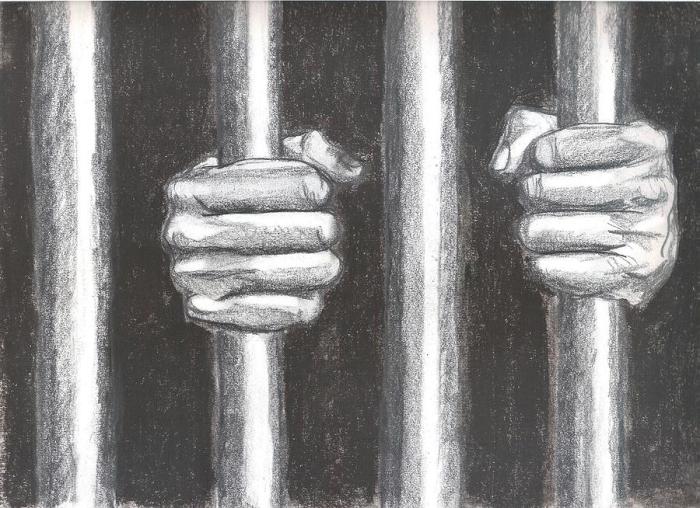Symbolism and Metaphor in Depiction

Easy drawing of inmate behind bars – Drawing an inmate behind bars offers a surprisingly rich canvas for exploring symbolism and metaphor. It’s not just about depicting a person imprisoned; it’s about conveying the weight of their experience, their inner state, and their potential for hope or despair. The seemingly simple act of drawing becomes a powerful tool for expressing complex emotions and ideas. We can use various artistic choices to subtly, or dramatically, shift the meaning and impact of the image.
Symbolic Elements Representing Confinement, Hope, and Despair
The choice of symbolic elements significantly impacts the overall message. For instance, the bars themselves can be more than just physical barriers. Thick, dark bars suggest overwhelming oppression, while thin, almost translucent lines might hint at a fragile confinement, perhaps even a metaphorical one. A single, bright flower pushing through a crack in the wall could represent hope against the odds.
Conversely, shadows stretching across the cell, or a wilting plant, can powerfully symbolize despair and the crushing weight of imprisonment. A cracked mirror, reflecting a distorted image of the inmate, could represent the loss of self and identity. The use of color also plays a crucial role; muted tones can reflect despair, while brighter colors might suggest resilience or a yearning for freedom.
Sometimes, the simplest sketches hold the deepest meaning. An easy drawing of an inmate behind bars can powerfully convey feelings of confinement and isolation. Think about the contrast – the stark simplicity of the lines depicting the bars juxtaposed with the potential complexity of the emotions within. Learning to draw such a scene can be surprisingly therapeutic, much like mastering the delicate art of an easy drawing of flabellate , which also requires precision and understanding of form.
Ultimately, both exercises teach us to see the beauty in even the most constrained situations, reflecting on the human condition within the lines we create.
Perspective and Framing to Emphasize Isolation or Connection
Perspective and framing are vital tools for manipulating the viewer’s perception. A close-up shot focusing solely on the inmate’s face, with the bars as a blurred background, emphasizes their inner world and emotions. This can create a sense of empathy and connection. In contrast, a wide shot showcasing the vast expanse of the prison, with the inmate a tiny figure in the distance, underscores their isolation and the overwhelming scale of their confinement.
Framing the inmate through the bars, creating a cage-like effect, reinforces the feeling of entrapment. Conversely, showing a glimpse of the outside world—a sliver of sky, a distant tree—through the bars introduces a sense of hope and a longing for freedom. The careful manipulation of these elements dramatically shifts the narrative.
Interpretations of a Simple Drawing of an Inmate Behind Bars, Easy drawing of inmate behind bars
Let’s consider a simple drawing: an inmate sitting hunched on a cot, behind bars. Here are three interpretations:
1. Interpretation 1
Despair and hopelessness. The inmate is slumped, head bowed, with his back to the viewer. The bars are thick and dark, almost obscuring the figure. The overall palette is muted, dominated by grays and browns. This conveys a sense of utter defeat and resignation.
2. Interpretation 2
Quiet contemplation and inner strength. The inmate sits with his head slightly raised, eyes gazing towards a barely visible light source. The bars are present, but not overwhelming. A subtle, hopeful color, like a faint blue, is present in the background. This suggests resilience, an inward journey of reflection and the quiet strength needed to endure hardship.
3. Interpretation 3
Yearning for freedom and hope. The inmate is shown reaching towards a small window, a faint light shining through the bars. The bars are depicted as less solid, perhaps even slightly blurred. The use of bright, warm colors suggests optimism and a persistent hope for liberation. The drawing focuses on the inmate’s outstretched hand, highlighting his desire for freedom.
Exploring Different Artistic Techniques: Easy Drawing Of Inmate Behind Bars

Creating a drawing of an inmate behind bars offers a unique opportunity to explore various artistic techniques, each lending a different mood and emphasizing various aspects of the subject. From the stark reality of pencil shading to the vibrant possibilities of digital art, the choice of medium significantly impacts the final piece. Let’s delve into some popular options and how they can be used to portray this complex theme.
Pencil Drawing: Shading and Texture
A simple pencil drawing allows for a nuanced approach to shading and texture, crucial for depicting the bars and the inmate’s clothing. Begin by sketching a light Artikel of the inmate and the bars. Use a lighter pencil (e.g., 2H or HB) for the initial sketch to avoid harsh lines. To create the bars, apply heavier pressure to the pencil, creating darker, thicker lines to suggest their metallic texture.
The spaces between the bars can be left lighter to contrast with the bars. For the inmate’s clothing, consider using different shading techniques. For example, cross-hatching can create a textured effect for rough fabric, while smooth blending can suggest softer materials. Darker shading can be used to suggest wrinkles or folds in the clothing, adding depth and realism.
Remember to consider light sources and how they would affect the shadows cast by the bars and the inmate’s body. This will add a sense of three-dimensionality to your artwork. Experiment with varying pencil grades (e.g., 2B, 4B, 6B) to achieve different levels of darkness and create depth.
Digital Drawing: Utilizing Software Tools
Digital drawing offers a level of control and flexibility unmatched by traditional methods. Programs like Krita (free and open-source) or Autodesk Sketchbook (free version available) provide a range of brushes, layers, and tools to refine your artwork. Start by sketching the basic Artikel, just as you would with a pencil. Then, utilize the program’s tools to add details. Digital brushes allow for precise control over line weight and texture, enabling you to realistically depict the metallic bars and the fabric of the inmate’s clothing.
Layers are invaluable for experimenting with different shading techniques and easily correcting mistakes without affecting other elements of the drawing. The undo function is a major advantage, allowing for experimentation without fear of ruining the work. The ability to easily adjust colors and values adds another layer of depth and realism. Finally, digital art allows for easy sharing and reproduction.
Comparing Different Artistic Mediums
The choice of medium significantly affects the final piece’s mood and style. A comparison of several mediums follows:
- Pencil: Offers fine detail and control, ideal for subtle shading and texture. The result is often realistic and detailed, suitable for a contemplative mood.
- Charcoal: Creates a dramatic, expressive effect with its dark, smudgeable quality. Well-suited for conveying a sense of confinement or despair.
- Pastels: Allow for vibrant color and soft blending, potentially creating a more hopeful or surreal interpretation.
- Ink: Provides sharp lines and bold contrasts, which can emphasize the harsh reality of imprisonment. Ink drawings can range from detailed and realistic to abstract and expressive.
Popular Questions
What are some common mistakes beginners make when drawing inmates?
Forgetting to consider the context and background, neglecting proportions, and not paying enough attention to shading and light.
Can I use this technique to draw other subjects besides inmates?
Absolutely! The techniques discussed here – shading, composition, perspective – are applicable to a wide range of subjects.
Where can I find inspiration for my drawings?
Look at other artists’ work, explore photography, and even use real-life observations as inspiration. Don’t be afraid to experiment!
